Borealpox virus

A borealpox lesion about 10 days after symptom onset.
More images are in
the borealpox FAQ.
Formerly known as Alaskapox
As of April 2024, the Alaska Department of Health has worked in consultation with the Centers for Disease Control and Prevention (CDC) and the World Health Organization to change the name of this virus from Alaskapox virus to borealpox virus. The corresponding disease will be called borealpox. This name references the ecosystem where the virus was first identified in both humans and small mammal reservoirs, it is less specific than the current name and thus offers greater latitude for the possibility of the virus being identified in small mammals (and humans) outside of Alaska.
Borealpox virus is an orthopoxvirus that was first identified in a patient in Fairbanks, Alaska, in 2015. Orthopoxviruses are known infect mammals, including humans, and can lead to the development of skin lesions. Since 2015, six additional cases of borealpox virus have been reported in Alaska, five of which were in persons living in the Fairbanks North Star Borough and one person was living in the Kenai Peninsula Borough.
Current evidence indicates that borealpox virus primarily occurs in small mammals. The virus has been most commonly identified in red-backed voles and shrews, based on small mammal sampling in the Fairbanks North Star Borough. However, it is likely that the virus is more widespread in Alaska's small mammal populations, and infections in humans may have occurred in other patients but were not diagnosed. Domestic pets (cats and dogs) may also play a role in spreading the virus.
To date, no human-to-human transmission of borealpox virus has been documented. However, since certain orthopoxviruses can be transmitted through direct contact with skin lesions, we recommend that people with skin lesions possibly caused by borealpox keep the affected area covered with a bandage.

The Northern Red-Backed Vole, found throughout Alaska, is one species that has shown evidence of having borealpox virus.
Symptoms of borealpox have included one or more skin lesions (bumps or pustules) and other symptoms like swollen lymph nodes and joint and/or muscle pain. Immunocompromised people might be at increased risk for more severe illness.
Healthcare providers who suspect borealpox virus infection and have not identified an alternative diagnosis should contact the Alaska Section of Epidemiology at 907-269-8000.
Resources